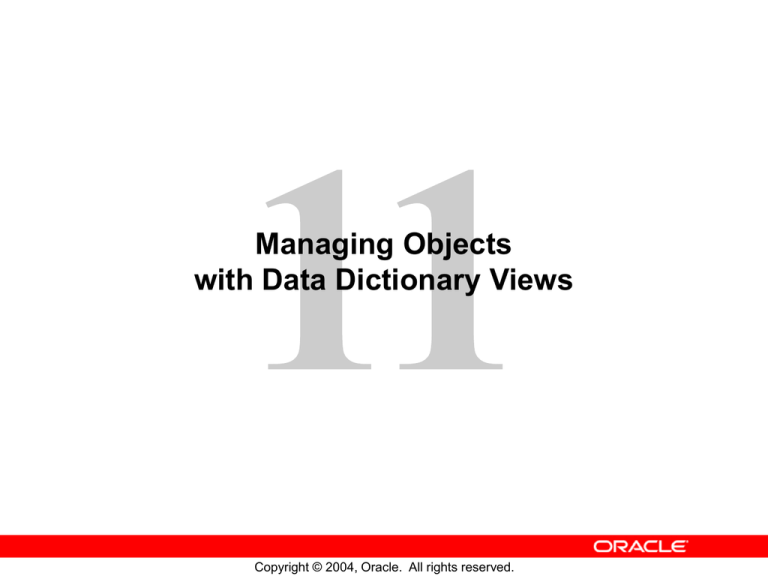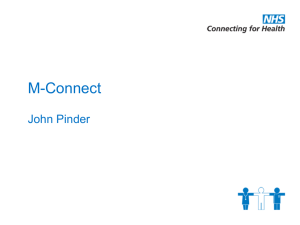
Managing Objects
with Data Dictionary Views
Copyright © 2004, Oracle. All rights reserved.
Objectives
After completing this lesson, you should be able to do
the following:
• Use the data dictionary views to research data on
your objects
• Query various data dictionary views
11-2
Copyright © 2004, Oracle. All rights reserved.
The Data Dictionary
Oracle server
Tables containing
business data:
EMPLOYEES
DEPARTMENTS
LOCATIONS
JOB_HISTORY
...
11-3
Data dictionary
views:
DICTIONARY
USER_OBJECTS
USER_TABLES
USER_TAB_COLUMNS
...
Copyright © 2004, Oracle. All rights reserved.
Data Dictionary Structure
Oracle server
Consists of:
– Base tables
– User-accessible views
11-4
Copyright © 2004, Oracle. All rights reserved.
Data Dictionary Structure
View naming convention:
11-5
View Prefix
USER
Purpose
ALL
Expanded user’s view (what you can
access)
DBA
Database administrator’s view (what is in
everyone’s schemas)
V$
Performance-related data
User’s view (what is in your schema;
what you own)
Copyright © 2004, Oracle. All rights reserved.
How to Use the Dictionary Views
Start with DICTIONARY. It contains the names and
descriptions of the dictionary tables and views.
DESCRIBE DICTIONARY
SELECT *
FROM
dictionary
WHERE table_name = 'USER_OBJECTS';
11-6
Copyright © 2004, Oracle. All rights reserved.
USER_OBJECTS View
•
•
Describes all objects that are owned by you
Is a useful way to obtain a listing of all object
names and types in your schema, plus the
following information:
– Date created
– Date of last modification
– Status (valid or invalid)
•
11-7
Queries ALL_OBJECTS to see all objects to which
you have access
Copyright © 2004, Oracle. All rights reserved.
USER_OBJECTS View
SELECT object_name, object_type, created, status
FROM
user_objects
ORDER BY object_type;
…
11-8
Copyright © 2004, Oracle. All rights reserved.
Table Information
USER_TABLES:
DESCRIBE user_tables
SELECT table_name
FROM
user_tables;
…
11-9
Copyright © 2004, Oracle. All rights reserved.
Column Information
USER_TAB_COLUMNS:
DESCRIBE user_tab_columns
…
11-10
Copyright © 2004, Oracle. All rights reserved.
Column Information
SELECT column_name, data_type, data_length,
data_precision, data_scale, nullable
FROM
user_tab_columns
WHERE table_name = 'EMPLOYEES';
11-11
Copyright © 2004, Oracle. All rights reserved.
Constraint Information
•
•
USER_CONSTRAINTS describes the constraint
definitions on your tables.
USER_CONS_COLUMNS describes columns that are
owned by you and that are specified in
constraints.
DESCRIBE user_constraints
…
11-12
Copyright © 2004, Oracle. All rights reserved.
Constraint Information
SELECT constraint_name, constraint_type,
search_condition, r_constraint_name,
delete_rule, status
FROM
user_constraints
WHERE table_name = 'EMPLOYEES';
11-13
Copyright © 2004, Oracle. All rights reserved.
Constraint Information
DESCRIBE user_cons_columns
SELECT constraint_name, column_name
FROM
user_cons_columns
WHERE table_name = 'EMPLOYEES';
…
11-14
Copyright © 2004, Oracle. All rights reserved.
View Information
1
DESCRIBE user_views
2
SELECT DISTINCT view_name FROM user_views;
3
SELECT text FROM user_views
WHERE view_name = 'EMP_DETAILS_VIEW';
11-15
Copyright © 2004, Oracle. All rights reserved.
Sequence Information
DESCRIBE user_sequences
11-16
Copyright © 2004, Oracle. All rights reserved.
Sequence Information
•
Verify your sequence values in the
USER_SEQUENCES data dictionary table.
SELECT
FROM
•
11-17
sequence_name, min_value, max_value,
increment_by, last_number
user_sequences;
The LAST_NUMBER column displays the next
available sequence number if NOCACHE is
specified.
Copyright © 2004, Oracle. All rights reserved.
Synonym Information
DESCRIBE user_synonyms
SELECT *
FROM
user_synonyms;
11-18
Copyright © 2004, Oracle. All rights reserved.
Adding Comments to a Table
•
You can add comments to a table or column by
using the COMMENT statement:
COMMENT ON TABLE employees
IS 'Employee Information';
Comment created.
•
Comments can be viewed through the data
dictionary views:
–
–
–
–
11-19
ALL_COL_COMMENTS
USER_COL_COMMENTS
ALL_TAB_COMMENTS
USER_TAB_COMMENTS
Copyright © 2004, Oracle. All rights reserved.
Summary
In this lesson, you should have learned how to find
information about your objects through the following
dictionary views:
• DICTIONARY
• USER_OBJECTS
• USER_TABLES
• USER_TAB_COLUMNS
• USER_CONSTRAINTS
• USER_CONS_COLUMNS
• USER_VIEWS
• USER_SEQUENCES
• USER_TAB_SYNONYMS
11-20
Copyright © 2004, Oracle. All rights reserved.
Practice 11: Overview
This practice covers the following topics:
• Querying the dictionary views for table and
column information
• Querying the dictionary views for constraint
information
• Querying the dictionary views for view information
• Querying the dictionary views for sequence
information
• Querying the dictionary views for synonym
information
• Adding a comment to a table and querying the
dictionary views for comment information
11-21
Copyright © 2004, Oracle. All rights reserved.






